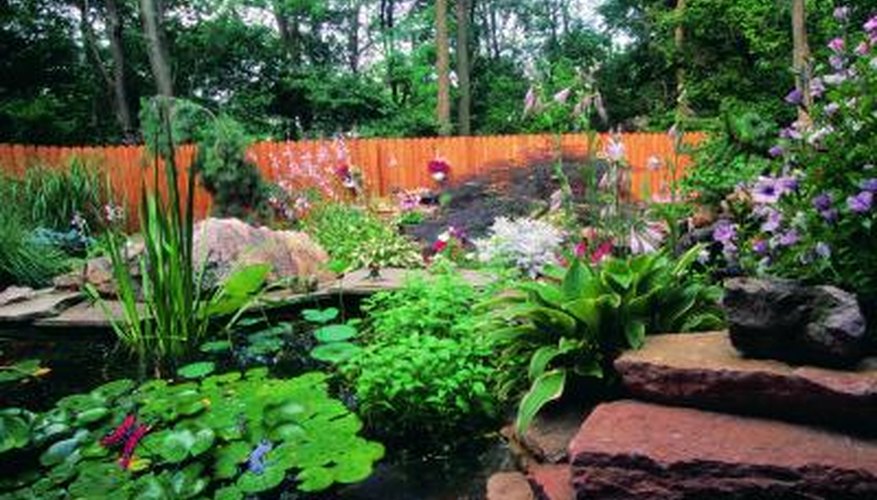A backyard sanctuary with the musical sounds of a babbling brook is within reach of a suburban gardener with a plan, a shovel, some water and a pile of rocks. A rocky stream flowing from a small waterfall into a modest rock-lined pond is all you need for your own private nature reserve that will attract some local wildlife. A shallow draft at one end of the pond, sunny basking stones for butterflies, bee- and bird-friendly vines and bushes along the edge of the rocks, and water will make a newly built environment seem as if it has always been there.
- A backyard sanctuary with the musical sounds of a babbling brook is within reach of a suburban gardener with a plan, a shovel, some water and a pile of rocks.
- A shallow draft at one end of the pond, sunny basking stones for butterflies, bee- and bird-friendly vines and bushes along the edge of the rocks, and water will make a newly built environment seem as if it has always been there.
Site the pond as close as possible to outdoor sources of power and water. Use a garden hose to outline the shape of the pond and view from a few angles to adjust it. Then mark the outline by digging it out with a shovel.
Purchase a heavy pond liner or a premade pond basin. Get extra pond liner to use under the stream and waterfall. Order quarry rock and gravel or reclaim rocks from your property for the whole water feature system.
Dig trenches for PVC pipe to hold power lines and water lines. Lay down the PVC pipe that will hold the electrical cords, and run water from an outdoor faucet to the pond. You may want to hire professionals to install power and plumbing fixtures, depending on your own expertise.
Dig the hole for the pond as well as the trench for the brook that will connect it to the waterfall. Layer sand on the bottom of the hole to protect the pond liner or create a level surface for a basin. Set pond liner or basin in hole.
- Dig trenches for PVC pipe to hold power lines and water lines.
- Layer sand on the bottom of the hole to protect the pond liner or create a level surface for a basin.
Drape pond liner over a shallow trench for the stream water course. Lay one end of the liner over the built-up mound that will support a small waterfall. Begin to fill in the streambed with gravel and small stones. Place gravel and small stones in the bottom of the pond as well.
Put the submersible filter and waterfall pump in the deepest part of the pond and hook up all lines. Run the water hose from the pump, up the stream but hidden by gravel, and to the top of the waterfall.
Use the rocks you reclaimed or purchased to build the waterfall, ensuring that some flat horizontal stones are used for the water to sheet over and create a visible fall. Randomly line the streambed and bank with stones in as natural a configuration as possible. Set stones around the perimeter of the pond, slightly built up to make a low wall with flatter stones on top. Cover the edges of the pond liner completely.
Fill the pond with water and try out the system. Make necessary adjustments to water flow and rearrange rocks and liner to prevent any leaks. When the system works well, add ground cover to the stream sides and pond perimeter and set aquatic plants in the pond. Plant taller shrubs in back of the waterfall and landscape the area around the water feature so it creates a seamless transition to the rest of the yard.
- Put the submersible filter and waterfall pump in the deepest part of the pond and hook up all lines.
- When the system works well, add ground cover to the stream sides and pond perimeter and set aquatic plants in the pond.
